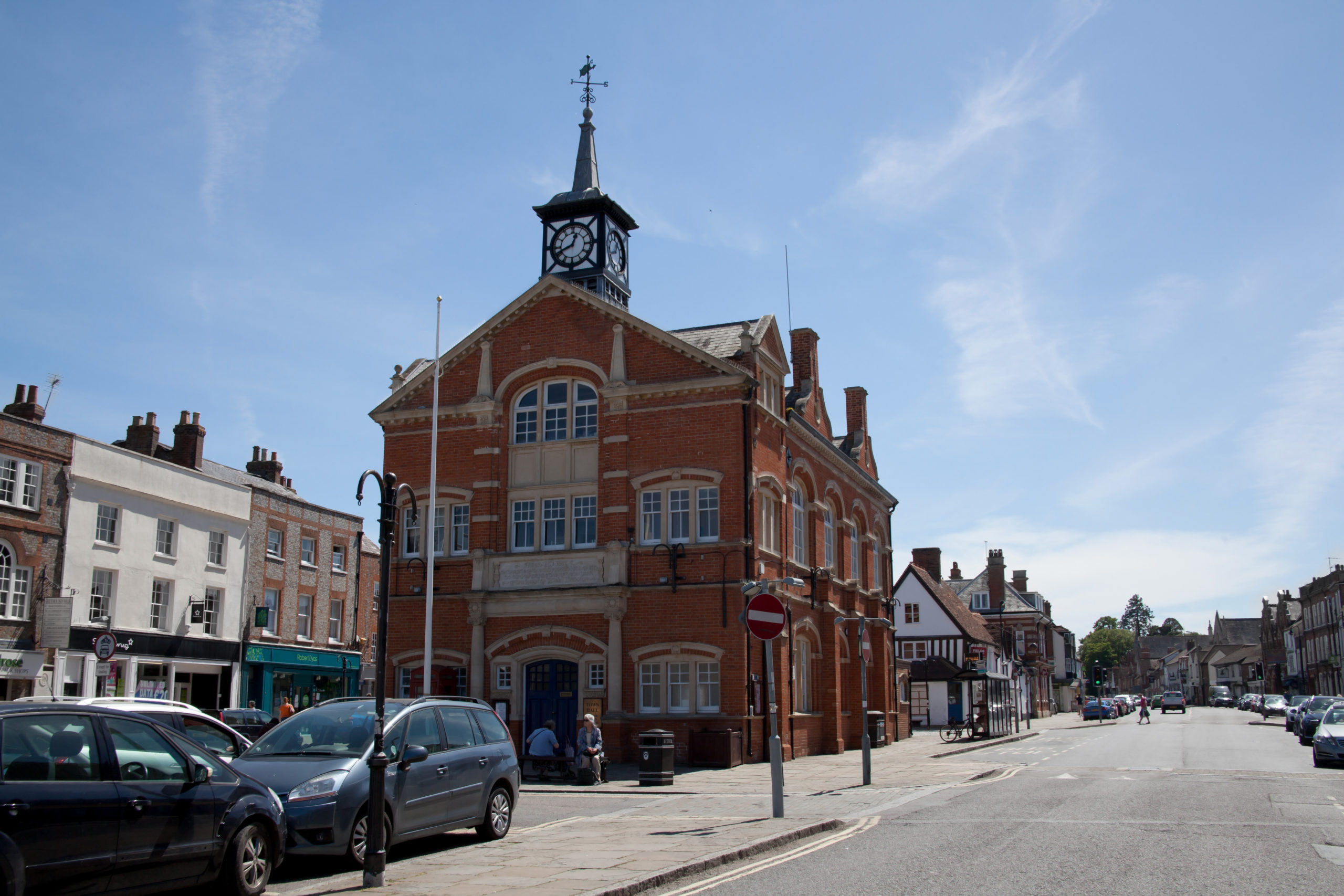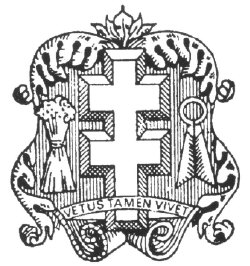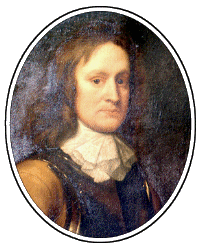
A History of Thame – overview and key dates

Thame, Oxfordshire, has a long and fascinating history going back approximately 6,000 years. This page contains information about some of Thame’s history and key dates – but if there’s something you think we should add then please get in touch!
‘Old Thame’ was the area known as Priestend where the road to Crendon crossed the river and the Aylesbury to Oxford road used to pass between the St Mary’s Church and Vicarage. Aerial photographs reveal a possible Saxon settlement by the River Thame and there have been stray finds of jewellery and pottery around the area.
The Thame badge (image), based on the design of a ring found in’ the Thame Hoard’ in 1940.
A quick overview of the history of Thame, Oxfordshire
In Saxon times, Thame consisted of a settlement down by the ‘dark flowing’ river from which the town takes its name.
Stribble Hills at Priest End is one of the oldest houses in Thame. You can’t miss this beautiful building as you head out of Thame towards Oxford along the top of the High Street.
Thame, before the Norman conquest, was in the diocese of Dorchester and it would, therefore, seem possible Thame was converted to Christianity by missionaries from Dorchester who could have rowed up the River Thame.
Thame remained in the above diocese until the early nineteenth century as a ‘peculiar’ (a parish outside the area of the diocese proper). The church was a prebend of Lincoln and the prebend was built to house his reeve or representative. It resembled a secular manor with its great hall and chapel.
The church, dedicated to St Mary the Virgin, dates in its present form from c1240 when it was rebuilt by Bishop Grossteste of Lincoln. The church contains work from every century since. The Tudor Chancel stalls and screen; the Jacobean alter table; Lord Williams’s central chancel tomb (uniquely positioned with feet towards the west); and the collection of monumental brasses (including a rare one to the first headmaster of the Grammar School) are especially noteworthy. The wealth of the church can also be gauged from the size of the neighbouring large tithe barn.
The original town developed around the church, but in the early thirteenth century the liberty of New Thame was ‘planted’ by the then Bishop of Lincoln on land formerly under plough. This can be seen by the passageways which follow the reverse ‘S’ curve. This is easily visible by the Old Saracen’s Head in the Buttermarket.
The marketplace has the typical boat-shaped appearance of a planted town with narrow entrances at both ends. The market has been held on Tuesdays since 1183, and received its Royal Charter in 1215, the original site being the Buttermarket and Cornmarket areas. The Buttermarket is traditionally sited on the cooler north side, the Cornmarket on the south. The area of Middle Row, which separates the two, originally consisted of booths that were taken down and put up each week.
They were gradually replaced by permanent structures, one of these being the Birdcage which is first mentioned in the early sixteenth century as belonging to the Guild of St Christopher, although parts of the building may be older than this. It also housed the Napoleonic Wars prisoners of other rank; the officers being housed in the Spread Eagle.
The Bishop of Lincoln did his utmost to ensure that all travellers patronised his market by diverting the road from Aylesbury so that it passed directly through it. Some of the oldest buildings extant in Thame are, therefore, to be found in North Street and the High Street. Walker’s in North Street and Lancastrian Cottage in the lower part of the High Street are early examples of prefabricated buildings in that the frames were made on the Chilterns, then brought down and assembled in situ to the individual owners’ specifications.
The town was troubled little by the Reformation. There is, though, the unsubstantiated legend of a heretic being burned at Priest End. The major effect of the Reformation was the suppression of the Cistercian monastery at Thame Park, where it had been since the mid-twelfth century after its removal from Oddington-on-Otmoor. The last abbot of Thame, Robert King, became the first Bishop of Oxford.
The Grammar School in Church Road was founded in 1559 by Lord William’s of Thame who had received preferment from four of the five Tudor Monarchs, including Elizabeth I whose gaoler had been at Rycote for a time. He also refounded the jettied Almshouses on the corner of Church Road which had originally been founded by Richard Quartermain for six old men and one woman.
Many of the inns in the town date from the sixteenth and seventeenth centuries. Some of these inns, such as the Swan, with its late sixteenth century paintings, and Nags Head, still fulfil the same function today while the Kings Head is now Rafferty Buckland, Estate Agents. The Civil War of the 1640s saw Thame as a kind of no-mans-land, occupied in turn by parliamentary and royalist forces.

John Hampden, a former pupil of the Grammar School, died of wounds received in the battle of Chalgrove Field in June 1643 at the Grayhound Inn, now Hampden House. Anthony Wood, the first historian of Oxford University, boarded at the vicarage and recorded in his diary a skirmish between the forces on the old Crendon Road.
John Hampden was descended from an ancient Buckinghamshire family of great wealth with a long tradition of service to the Crown. Born in 1594, probably in London, he was educated at Lord Williams’s Grammar School, Thame, and Magdalen College, Oxford. By the time of his death in Thame John Hampden had received the title by which he has ever since been known – ‘The Patriot’.
The eighteenth century was a quiet time for Thame. Many of the houses in the High Street and Upper High Street were built in the Georgian manner or at least refaced with the attractive local saltglazed brick. The century saw the growth of coach travel and four important inns were functioning by the end of it – the Greyhound, the Red Lion (now Lightfoot’s Solicitors), the Swan, and the Spread Eagle Hotel, then just the Eagle. (The latter two still function in the same capacity today).
It was also in the latter part of the century that John Wesley preached in Thame, in an upper room of a cottage on the site of Coral’s bookmakers, to such a crowd that the floor gave way and the congregation enjoyed a sudden descent to the lower regions.
The town in the nineteenth century was very poor because of extremely low agricultural wages, agriculture being the main industry and there were hardly any large landowners to defray the expense of the poor law. This aspect of the history of Thame is reflected visibly in the large Victorian Workhouse on the Oxford Road, now the home of Rycotewood College.
The early part of the century saw the building of the Countess of Huntingdon Chapel in the middle of Upper High Street. This sect is best described as Yuppy Methodists. The building is now the only one of its kind in existence and is now occupied by the Tourist Information Centre and Citizens Advice Bureau. The area that is Park Street, then Brickiln Lane, also developed in the first four decades of the century when the John Hampden School, then the British School, was opened in 1837.
The town expanded in the latter part of the nineteenth century. An area that saw building was Chinnor Road where cottages and the Tin Church of All Saints were built for the navvies who worked on the railway line which connected Thame with Oxford and London via High Wycombe. Croft and Queens road and Nelson Street were also built and Wellington Street, previously known as Pound Lane, was made into a through road which connected North Street with Risborough Road.
The Grammar School was re-housed in 1879 in buildings on Oxford road. The present Town Hall, was built in 1887/88 to commemorate Queen Victoria’s Golden Jubilee. The William and Mary Market Hall was taken down to make way for it.
The Diamond Jubilee of 1887 was marked by the building of the Victoria Cottage Hospital and a day centre was opened next to it in 1987 by Princess Margaret after a large local fund-raising appeal. The magistrates’ court – a one-storeyed building surmounted by the Royal coat of arms – was built in the lower High Street. The Police Station was built at the junction of Chinnor and Thame Parks roads in the 1860s and was the oldest in the country in use until 1992 when it moved to new premises in Greyhound Lane.
The last century has seen Thame grow from a population of 3,000 in 1901 to 11,000+ today. This has meant that Thame has, over the last 40 years, ceased to become a predominantly agricultural town, although Pearces, a woolstaplers since at least the fifteenth century, remains. There is a large industrial estate on the outskirts with factories and offices. The weekly Tuesday market is still held in the Upper High Street car park. The cattle market though was moved to North Street in 1951 and is now held on Wednesdays and Fridays. The War Memorial in Upper High Street is a reminder of the two world wars. Next to the war memorial are the Pearce (local woolstaplers)
Memorial Gardens with a fountain and a statue of a boy. The original statue was erected in 1926 by Ernest Pearce of Australia as a monument to the memory of his parents Philip Henry Pearce and his wife Elizabeth. The bronze fountain statue was stolen in September 1985 and was never recovered. In the summer of 1992, a replica of the original statue was commissioned by the Town Council. The blue plaque on the front of the Spread Eagle remembers the time when John Fothergill, the renowned and innovative hotelier, was then its owner.
Thame lost its railway station in 1964, but the Haddenham and Thame Parkway was re-established in 1987 just over the Buckinghamshire border, as a passenger only station. This suggests that Thame is no longer agricultural but is a centre needing rail as well as road links.
Every year (though not 2012), the town still stages the largest one-day agricultural show in the country in July. On the third Thursday of September, a three day fair is held in the High Street and Upper High Street. A smaller two-day charter fair is held in mid-October and these, together with the weekly Tuesday market, maintain continuity with the town’s history and together form a link between the past and present.
Thame continues to grow and expand to this day with new housing and businesses moving into the area. With its rich history and community feel, hopefully Thame will continue to maintain its charm.
Thame sees its fair share of visitors from the UK and afar with the Midsomer Murder Tours being a particular draw as well as the great places to eat and drink – and of course its convenient location for Oxford, London and Bicester.
Key dates in the history of Thame
675 – the King of Mercia signed a charter at Thame.
971 Oscytel, Bishop of Dorchester and later Archbishop of York, died in Thame.
1085 Thame appears in the Domesday Book as belonging to the Bishop of Lincoln. Successive bishops of Lincoln were lords of the manor of Thame until Tudor times.
1215 a royal charter granting a market at Thame was obtained.
The church, dedicated to St Mary the Virgin, dates in its present form from c1240 when it was rebuilt by Bishop Grossteste of Lincoln.
14th C the picturesque double-jettied Bird Cage dates from this era. Built originally as the Market House with an open lower storey, it has served as an inn since the 16th Century.
1559 the Grammar School in Church Road was founded by Lord William’s of Thame.
1640s – The Civil War saw Thame as a kind of no-mans-land, occupied in turn by parliamentary and royalist forces.
June 1643 – John Hampden, a former pupil of the Grammar School, died of wounds received in the battle of Chalgrove Field.
1684 – The prize-fighter James Figg was born in Thame.
1836 – Thame Union Workhouse was built.
1837 – John Hampden School, then the British School, was opened.
1840, the letter with the very first Penny Black stamp ever issued was delivered to Mr George Wakeman, High Street, Thame.
The town expanded in the latter part of the nineteenth century including the area of Chinnor Road, Croft, Queens Road, Nelson Street and Wellington Street.
1861 – The County Court was built from local brick (now Thame Museum).
1887/88 – Town Hall was built to commemorate Queen Victoria’s Golden Jubilee.
1879 – The new Lord Williams’s School built to replace a building previously used in Church Road.
1895 – Southern Road Recreation Ground was given to the town by trustees on behalf of the Hon. Francis Bertie.
1913 – St Mary’s Church Hall was founded (now Thame Theatre), although not completed until 1928.
1921 – The white Portland stone War Memorial was unveiled by Prime Minister David Lloyd George.
1950s, the town’s livestock market moved to a new site in North Street.
1951 – Elms Park was given to the town to be maintained as a park and recreation ground for the town. The gift was made by Mr and Mrs Leonard Purser who then lived at The Elms.
1960s, Thame railway station closed, after 100 years of operation.
1970s, the Lea Park housing estate was built.
1984 – The County Court was altered to accommodate the Magistrates Court.
1995 – Cuttle Brook Nature Reserve was created.
In 1997 Sustrans secured it as part of Route 57 of the National Cycle Network.
1997 – St Mary’s Church Hall was taken over by Thame Players and re-opened after a complete refurbishment in 2002.
2005 – The County Court was purchased by the Town Council to house the Thame Museum.
In June 2008, an extension of the Phoenix Trail was officially opened.
CAN YOU CONTRIBUTE TO TELLING THE HISTORY OF THAME?
Although we spent many days researching information to update this page – we know there’s far more to tell of the history of Thame. Can you help us add to this page or do you think an event in our town history deserves its own page?
We’d love to hear from you if you can help us build on the information we already have on the history of Thame.
Other places to read about the history of Thame
British History Online – Thame: Trade, industry and agriculture





